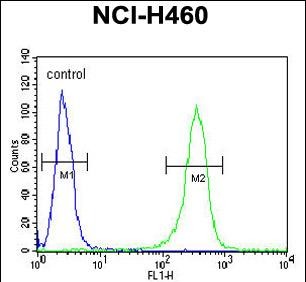ZN473 Antibody (N-term)
Affinity Purified Rabbit Polyclonal Antibody (Pab)
- SPECIFICATION
- CITATIONS: 1
- PROTOCOLS
- BACKGROUND

Application
| FC, WB, E |
|---|---|
| Primary Accession | Q8WTR7 |
| Reactivity | Human |
| Host | Rabbit |
| Clonality | Polyclonal |
| Isotype | Rabbit IgG |
| Calculated MW | 100182 Da |
| Antigen Region | 178-207 aa |
| Gene ID | 25888 |
|---|---|
| Other Names | Zinc finger protein 473, Zinc finger protein 100 homolog, Zfp-100, ZNF473, KIAA1141, ZFP100 |
| Target/Specificity | This ZN473 antibody is generated from rabbits immunized with a KLH conjugated synthetic peptide between 178-207 amino acids from the N-terminal region of human ZN473. |
| Dilution | FC~~1:10~50 WB~~1:1000 E~~Use at an assay dependent concentration. |
| Format | Purified polyclonal antibody supplied in PBS with 0.09% (W/V) sodium azide. This antibody is purified through a protein A column, followed by peptide affinity purification. |
| Storage | Maintain refrigerated at 2-8°C for up to 2 weeks. For long term storage store at -20°C in small aliquots to prevent freeze-thaw cycles. |
| Precautions | ZN473 Antibody (N-term) is for research use only and not for use in diagnostic or therapeutic procedures. |
| Name | ZNF473 |
|---|---|
| Synonyms | KIAA1141, ZFP100 |
| Function | Involved in histone 3'-end pre-mRNA processing by associating with U7 snRNP and interacting with SLBP/pre-mRNA complex. Increases histone 3'-end pre-mRNA processing but has no effect on U7 snRNP levels, when overexpressed. Required for cell cycle progression from G1 to S phases. |
| Cellular Location | Nucleus. Note=Stable component of Cajal bodies (CBs). Colocalizes with SMN, coilin and U7 snRNA |

Provided below are standard protocols that you may find useful for product applications.
References
Wagner, E.J., et al. Mol. Cell. Biol. 26(17):6702-6712(2006)
Wagner, E.J., et al. RNA 12(7):1206-1218(2006)
Pillai, R.S., et al. Genes Dev. 17(18):2321-2333(2003)
Dominski, Z., et al. Genes Dev. 16(1):58-71(2002)
If you have used an Abcepta product and would like to share how it has performed, please click on the "Submit Review" button and provide the requested information. Our staff will examine and post your review and contact you if needed.
If you have any additional inquiries please email technical services at tech@abcepta.com.














 Foundational characteristics of cancer include proliferation, angiogenesis, migration, evasion of apoptosis, and cellular immortality. Find key markers for these cellular processes and antibodies to detect them.
Foundational characteristics of cancer include proliferation, angiogenesis, migration, evasion of apoptosis, and cellular immortality. Find key markers for these cellular processes and antibodies to detect them. The SUMOplot™ Analysis Program predicts and scores sumoylation sites in your protein. SUMOylation is a post-translational modification involved in various cellular processes, such as nuclear-cytosolic transport, transcriptional regulation, apoptosis, protein stability, response to stress, and progression through the cell cycle.
The SUMOplot™ Analysis Program predicts and scores sumoylation sites in your protein. SUMOylation is a post-translational modification involved in various cellular processes, such as nuclear-cytosolic transport, transcriptional regulation, apoptosis, protein stability, response to stress, and progression through the cell cycle. The Autophagy Receptor Motif Plotter predicts and scores autophagy receptor binding sites in your protein. Identifying proteins connected to this pathway is critical to understanding the role of autophagy in physiological as well as pathological processes such as development, differentiation, neurodegenerative diseases, stress, infection, and cancer.
The Autophagy Receptor Motif Plotter predicts and scores autophagy receptor binding sites in your protein. Identifying proteins connected to this pathway is critical to understanding the role of autophagy in physiological as well as pathological processes such as development, differentiation, neurodegenerative diseases, stress, infection, and cancer.


